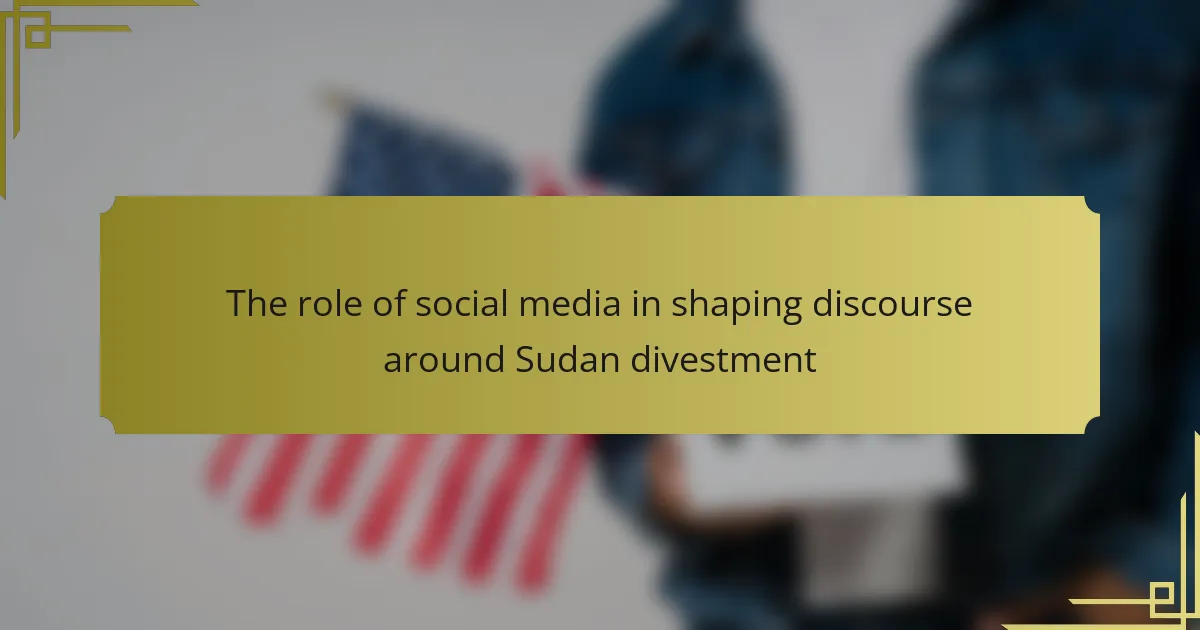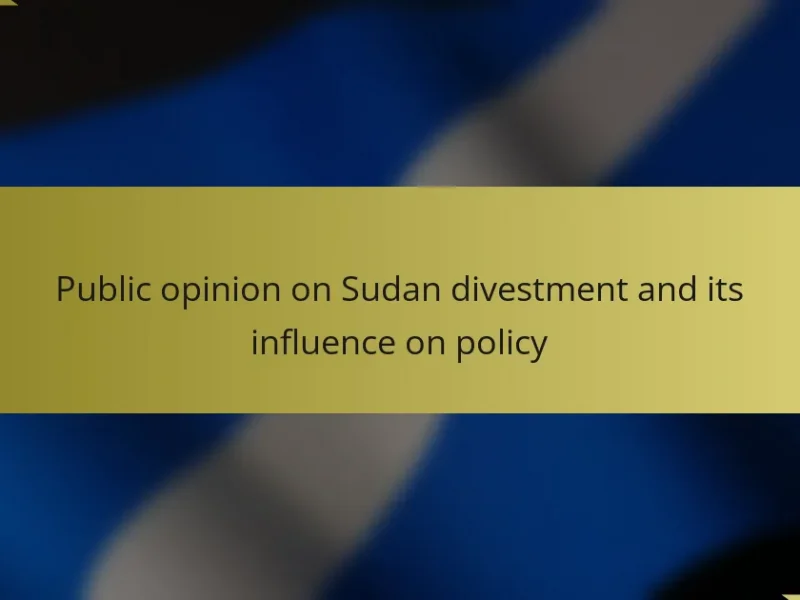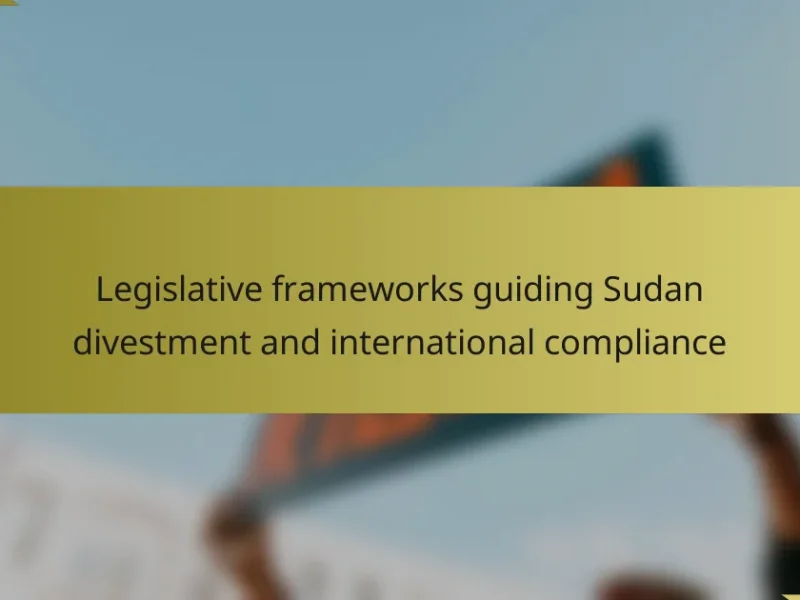Social media is a significant platform influencing the discourse surrounding Sudan divestment, enabling activists to raise awareness about human rights abuses and mobilize support. Through the use of hashtags like #SudanDivestment, users share personal stories and information that highlight the urgency of divestment efforts. However, challenges such as misinformation, limited access to reliable sources, and censorship can hinder constructive dialogue. Effective social media strategies, including targeted messaging and collaboration with influencers, can enhance advocacy efforts and increase public engagement on this critical issue. The article explores these dynamics, emphasizing the impact of social media on public opinion and corporate policies related to Sudan divestment.
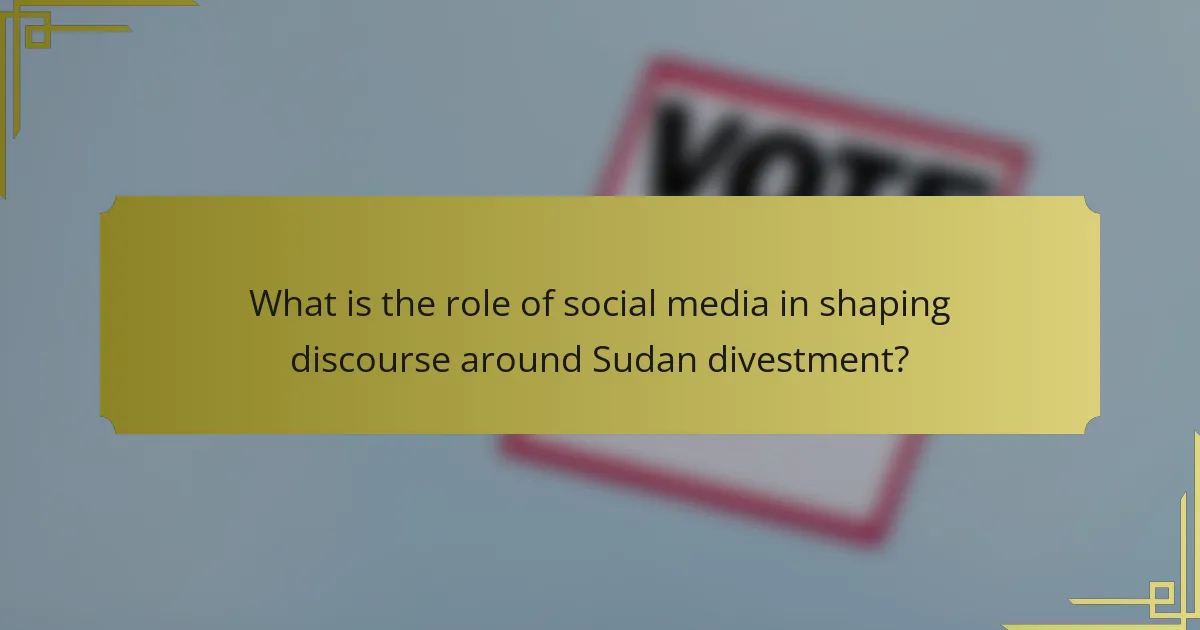
What is the role of social media in shaping discourse around Sudan divestment?
Social media plays a crucial role in shaping discourse around Sudan divestment. It serves as a platform for activists to raise awareness and mobilize support. Social media facilitates the dissemination of information regarding the human rights abuses in Sudan. Users share personal stories and reports that highlight the need for divestment. Hashtags like #SudanDivestment create a unified message that gains traction. This digital engagement influences public opinion and pressures institutions to reconsider their investments. Research shows that social media campaigns can lead to tangible changes in corporate policies. The visibility provided by social media amplifies the voices of those advocating for justice in Sudan.
How has social media influenced public awareness of Sudan divestment?
Social media has significantly increased public awareness of Sudan divestment. Platforms like Twitter and Facebook have facilitated real-time sharing of information. Activists use these platforms to mobilize support and spread awareness about the divestment movement. Campaigns often go viral, reaching wider audiences quickly. Hashtags like #SudanDivestment have helped unify discussions. This online engagement has led to increased pressure on companies to withdraw investments. Reports indicate that social media campaigns have influenced policy discussions. For instance, the Sudan divestment movement gained traction after being highlighted on various social media channels.
What platforms are most effective in promoting discourse on Sudan divestment?
Twitter and Facebook are the most effective platforms for promoting discourse on Sudan divestment. Twitter’s character limit encourages succinct, impactful messaging. It facilitates real-time discussions and engagement through hashtags like #SudanDivestment. Facebook allows for longer posts and community building through groups focused on divestment. Both platforms enable the sharing of articles, petitions, and events related to Sudan divestment. Research shows that social media campaigns can significantly influence public opinion and mobilize grassroots movements. For instance, the Sudan divestment movement gained momentum through organized campaigns on these platforms, leading to increased awareness and action among individuals and institutions.
How do social media campaigns mobilize support for Sudan divestment?
Social media campaigns mobilize support for Sudan divestment by raising awareness and facilitating communication. These campaigns utilize platforms like Twitter and Facebook to disseminate information rapidly. They engage users through hashtags, calls to action, and visual content. This engagement often leads to increased public interest and participation. For example, campaigns can highlight human rights abuses in Sudan, prompting users to advocate for divestment. Studies have shown that social media can amplify grassroots movements, making them more visible to policymakers. The combination of online mobilization and offline actions can create significant pressure on institutions to divest.
Why is social media a critical tool for activists discussing Sudan divestment?
Social media is a critical tool for activists discussing Sudan divestment because it facilitates rapid information sharing and mobilization. Activists can reach a global audience instantly, raising awareness about the divestment movement. Platforms like Twitter and Facebook allow for real-time updates and engagement with supporters. This immediate communication fosters community and solidarity among activists. Furthermore, social media enables the dissemination of educational content about the situation in Sudan. It helps to inform the public and policymakers about the impacts of divestment. According to a study published in the Journal of Communication, social media significantly amplifies grassroots movements. The study highlights that 70% of activists reported increased engagement through these platforms.
What are the advantages of using social media for advocacy?
Social media offers significant advantages for advocacy. It allows organizations to reach a broader audience quickly. This rapid dissemination of information can mobilize support efficiently. Social media platforms enable real-time engagement with followers. Advocates can respond to inquiries and comments instantly. The shareability of content enhances visibility and reach. Statistics show that social media campaigns can increase engagement by up to 100%. This increased interaction fosters community building among supporters. Additionally, social media provides cost-effective marketing options compared to traditional media. These factors contribute to a more impactful advocacy effort.
How does social media facilitate connections among activists?
Social media facilitates connections among activists by providing platforms for communication and collaboration. It allows activists to share information quickly and widely. Social media enables the formation of networks across geographical boundaries. Activists can join groups that align with their causes. These platforms support real-time updates on campaigns and events. They also foster discussions that can lead to collective action. Research shows that social media can amplify voices and mobilize support effectively. A study by the Pew Research Center found that 69% of adults use social media, making it a powerful tool for activism.
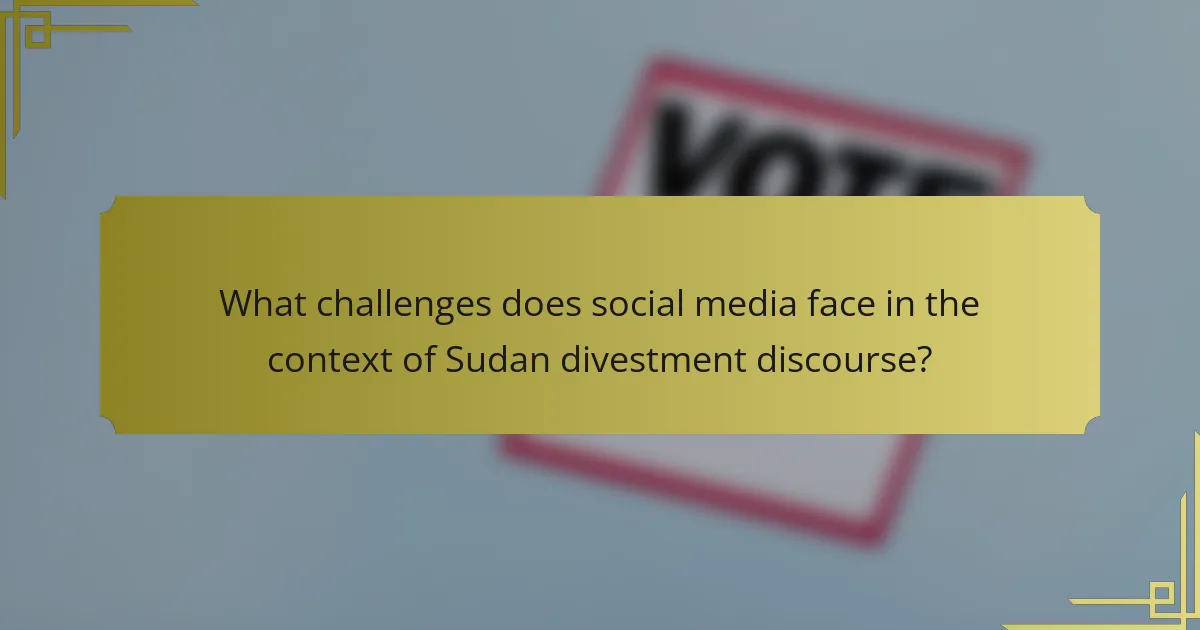
What challenges does social media face in the context of Sudan divestment discourse?
Social media faces significant challenges in the context of Sudan divestment discourse. Misinformation can spread rapidly, leading to confusion about the divestment efforts. Limited access to reliable sources hampers informed discussions among users. Censorship and government restrictions can stifle free expression on these platforms. Additionally, the digital divide affects participation, as many individuals lack internet access. Emotional responses can overshadow rational debate, complicating discourse. Finally, the complexity of the Sudan divestment issue makes it difficult to convey nuanced perspectives effectively. These challenges hinder constructive engagement and informed dialogue on social media regarding Sudan divestment.
How do misinformation and fake news impact discussions on Sudan divestment?
Misinformation and fake news significantly distort discussions on Sudan divestment. They create confusion about the reasons for divestment and the entities involved. This misinformation often leads to polarized opinions among stakeholders. Stakeholders may misinterpret the economic and ethical implications of divestment. For instance, false narratives can exaggerate the risks or benefits of divestment. This can result in misguided investment decisions. Additionally, misinformation can undermine trust in credible sources and expert opinions. Studies show that social media amplifies these misleading narratives rapidly. The impact of misinformation complicates collective action toward ethical investment practices.
What strategies can be employed to combat misinformation on social media?
Employing fact-checking initiatives is a key strategy to combat misinformation on social media. Fact-checking organizations can verify claims and provide accurate information. Research shows that users are less likely to believe false information when they encounter fact-checks. Promoting media literacy among users is also crucial. Educating individuals on how to identify credible sources reduces the spread of misinformation. Social media platforms can implement algorithms to detect and flag false content. This proactive approach helps limit the visibility of misleading posts. Encouraging users to report misinformation can enhance community engagement in combating false narratives. Collaboration with trusted organizations can strengthen efforts against misinformation. These strategies collectively create a more informed online environment.
How does the digital divide affect participation in Sudan divestment discourse?
The digital divide significantly limits participation in Sudan divestment discourse. Access to technology and the internet is unevenly distributed in Sudan. Many individuals lack reliable internet access, hindering their ability to engage in online discussions. This disparity affects awareness of divestment issues and related campaigns. Consequently, marginalized communities remain voiceless in the discourse. Research shows that digital literacy is also a barrier, as many may not know how to navigate social media platforms effectively. Without equal access, the discourse becomes dominated by those with better technological resources. This imbalance can lead to skewed perspectives in the conversation surrounding Sudan divestment.
What role do influencers play in shaping the narrative around Sudan divestment?
Influencers play a significant role in shaping the narrative around Sudan divestment. They leverage their platforms to raise awareness about the humanitarian issues in Sudan. Influencers often share information about the impact of divestment on local communities. Their reach can mobilize public opinion and encourage action among their followers. By promoting campaigns, they can drive engagement and support for divestment efforts. Research shows that social media discussions led by influencers can influence decision-making among consumers and investors. This impact is evident in various campaigns where influencers have successfully advocated for ethical investment practices.
How can influencers effectively advocate for Sudan divestment on social media?
Influencers can effectively advocate for Sudan divestment on social media by raising awareness and sharing factual information. They should create engaging content that highlights the humanitarian crisis in Sudan. Influencers can use statistics to illustrate the impact of divestment on local communities. Collaborating with NGOs can provide credible sources for their messages. Engaging followers through live discussions can foster a sense of community and urgency. Posting calls to action encourages their audience to participate in divestment campaigns. Utilizing hashtags related to Sudan divestment can increase visibility and reach. Consistency in messaging reinforces their commitment to the cause.
What are the potential risks of influencer involvement in social movements?
Influencer involvement in social movements can lead to several potential risks. One risk is the dilution of the movement’s message. Influencers may prioritize personal branding over the cause, leading to mixed messages. Another risk is the potential for misinformation. Influencers may inadvertently spread false information, harming the movement’s credibility. Additionally, there is the risk of commodification. Influencers might turn serious issues into marketing opportunities, undermining the movement’s integrity. Moreover, the reliance on influencers can create a lack of grassroots support. This can result in superficial engagement rather than meaningful action. Lastly, influencer involvement can lead to backlash. Critics may view influencers as opportunistic, which can alienate potential supporters. These risks highlight the complexities of influencer participation in social movements, particularly in sensitive contexts like Sudan divestment.
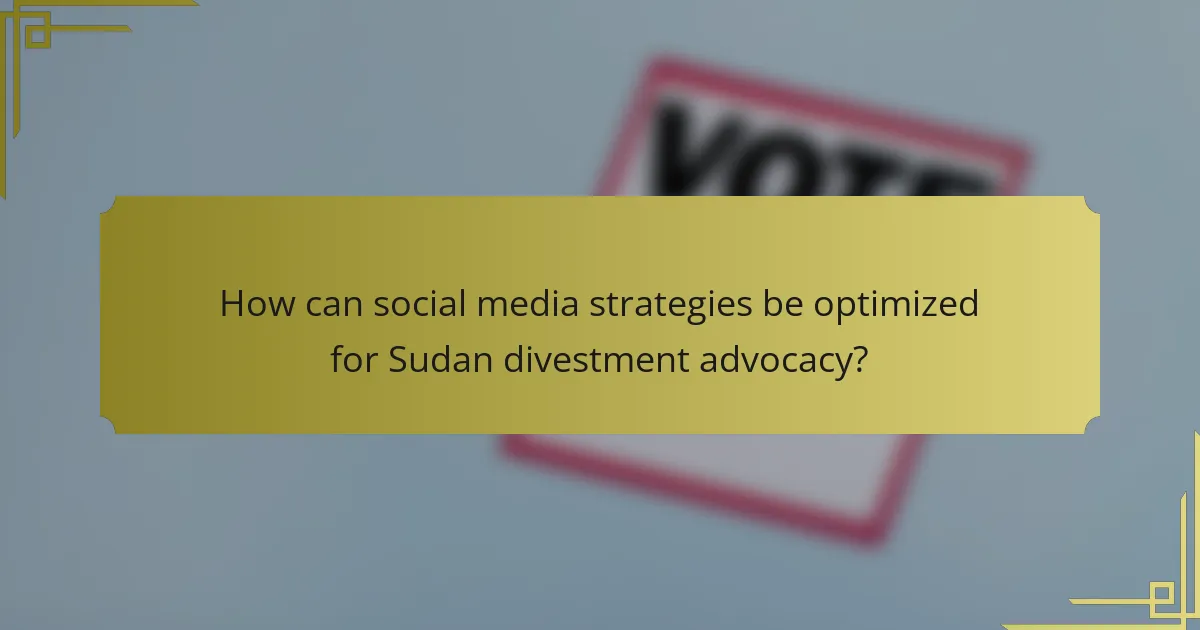
How can social media strategies be optimized for Sudan divestment advocacy?
Social media strategies for Sudan divestment advocacy can be optimized by focusing on targeted messaging and audience engagement. Identifying key demographics interested in Sudan divestment is essential. Tailoring content to resonate with these groups increases engagement rates. Utilizing visual storytelling can effectively convey complex issues surrounding divestment. Platforms like Twitter and Instagram can amplify messages through hashtags and shareable content. Collaborating with influencers can expand reach and credibility. Regularly analyzing engagement metrics helps refine strategies. A study by the Pew Research Center found that social media significantly influences public opinion, highlighting its potential in advocacy efforts.
What best practices should activists follow when using social media for Sudan divestment?
Activists should follow several best practices when using social media for Sudan divestment. First, they must create clear and compelling messages. These messages should articulate the reasons for divestment and its impact on Sudan. Second, activists should engage with their audience regularly. This engagement can foster a community of supporters who amplify the message. Third, using visual content is essential. Infographics and videos can effectively convey complex information. Fourth, activists should utilize relevant hashtags. This practice increases visibility and connects the campaign to broader conversations. Fifth, they must collaborate with other organizations. Partnerships can enhance credibility and expand reach. Sixth, monitoring analytics is crucial. Understanding audience engagement helps refine strategies. Lastly, activists should remain respectful and constructive in discussions. This approach promotes a positive dialogue around the issue. These practices are supported by successful campaigns that have effectively mobilized public opinion and action.
How can data analytics enhance social media campaigns on Sudan divestment?
Data analytics can enhance social media campaigns on Sudan divestment by providing insights into audience behavior and preferences. It enables organizations to identify key demographics interested in divestment issues. Analytics can track engagement metrics, such as likes, shares, and comments, to evaluate campaign effectiveness. Furthermore, sentiment analysis can gauge public opinion regarding Sudan divestment initiatives. This data helps refine messaging strategies to resonate better with audiences. Additionally, predictive analytics can forecast trends, allowing campaigns to adapt proactively. Research shows that data-driven campaigns are 5-10 times more effective in reaching target audiences than traditional methods.
What types of content are most engaging for audiences discussing Sudan divestment?
Informative articles and personal narratives are the most engaging content types for audiences discussing Sudan divestment. Informative articles provide context, data, and analysis on the implications of divestment. They often highlight the economic and social impacts of divestment strategies. Personal narratives offer emotional resonance and real-world implications, making the issue relatable.
Visual content, such as infographics and videos, enhances engagement by presenting complex information in digestible formats. Social media posts that include statistics or calls to action also capture attention effectively. Research indicates that audiences are more likely to share content that resonates emotionally and provides actionable insights.
Engaging content often includes case studies of successful divestment campaigns. These examples serve to inspire and motivate audiences to take action. Overall, a mix of informative, personal, and visual content tends to generate the most engagement in discussions surrounding Sudan divestment.
What are the future trends in social media advocacy for Sudan divestment?
Future trends in social media advocacy for Sudan divestment include increased use of visual storytelling and data-driven campaigns. Advocates are leveraging platforms like Instagram and TikTok to share impactful narratives. This approach aims to engage younger audiences who prefer visual content. Additionally, the integration of real-time data analytics will enhance campaign strategies. Organizations will monitor social media engagement metrics to refine their messaging. Collaborative efforts with influencers are also expected to rise. Influencers can amplify the message to broader audiences. Social media platforms will likely introduce new features to support advocacy efforts. Features may include donation tools and awareness campaigns. These trends indicate a shift towards more interactive and impactful advocacy strategies.
How might emerging technologies shape the discourse around Sudan divestment?
Emerging technologies can significantly influence the discourse surrounding Sudan divestment. Social media platforms enable rapid dissemination of information about Sudan’s political and economic conditions. This immediacy allows activists and organizations to mobilize support effectively. Technologies like blockchain can enhance transparency in financial transactions related to divestment efforts. Data analytics tools can identify trends and sentiments in public opinion regarding divestment. Additionally, virtual reality can create immersive experiences that raise awareness about the humanitarian crises in Sudan. These technologies collectively empower stakeholders to engage more dynamically in the conversation.
What can activists learn from past social media campaigns related to Sudan divestment?
Activists can learn the importance of strategic messaging from past social media campaigns related to Sudan divestment. Effective campaigns utilized clear, concise language to convey their message. They also leveraged visual content to enhance engagement and reach. Timing played a crucial role; campaigns aligned with significant events gained more traction. Building coalitions with established organizations increased credibility and amplified the message. Data-driven approaches helped in targeting specific demographics effectively. Furthermore, successful campaigns maintained transparency to build trust with supporters. Lastly, measuring impact through analytics allowed activists to refine their strategies for future initiatives.
The main entity of the article is social media and its role in shaping discourse around Sudan divestment. The article examines how social media platforms facilitate awareness and mobilization for divestment efforts by disseminating information about human rights abuses in Sudan. It highlights the effectiveness of platforms like Twitter and Facebook in promoting discussions, engaging audiences, and influencing public opinion. Additionally, the article addresses the challenges posed by misinformation and the digital divide, while also exploring the impact of influencers and strategies for optimizing social media advocacy in the context of Sudan divestment.
